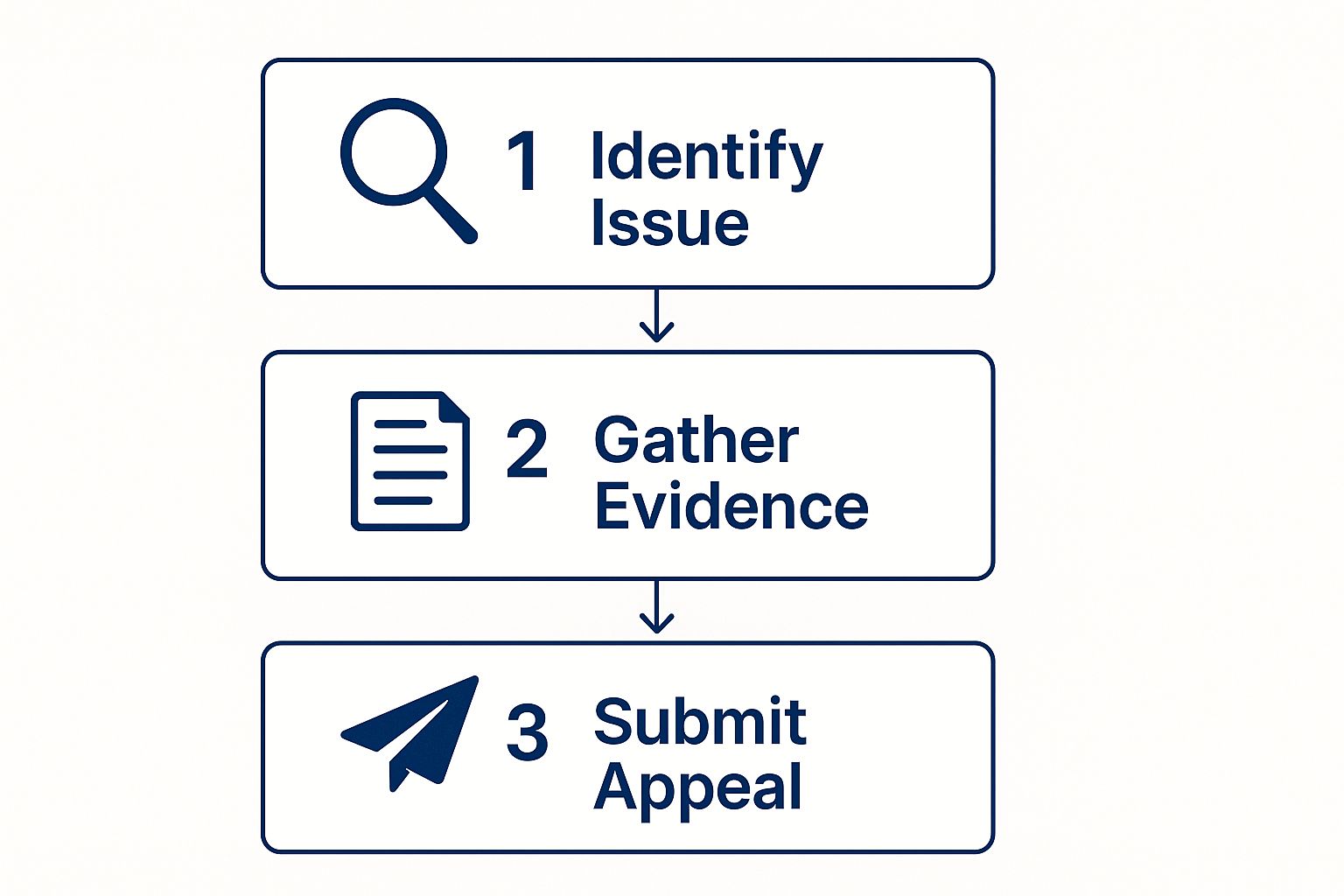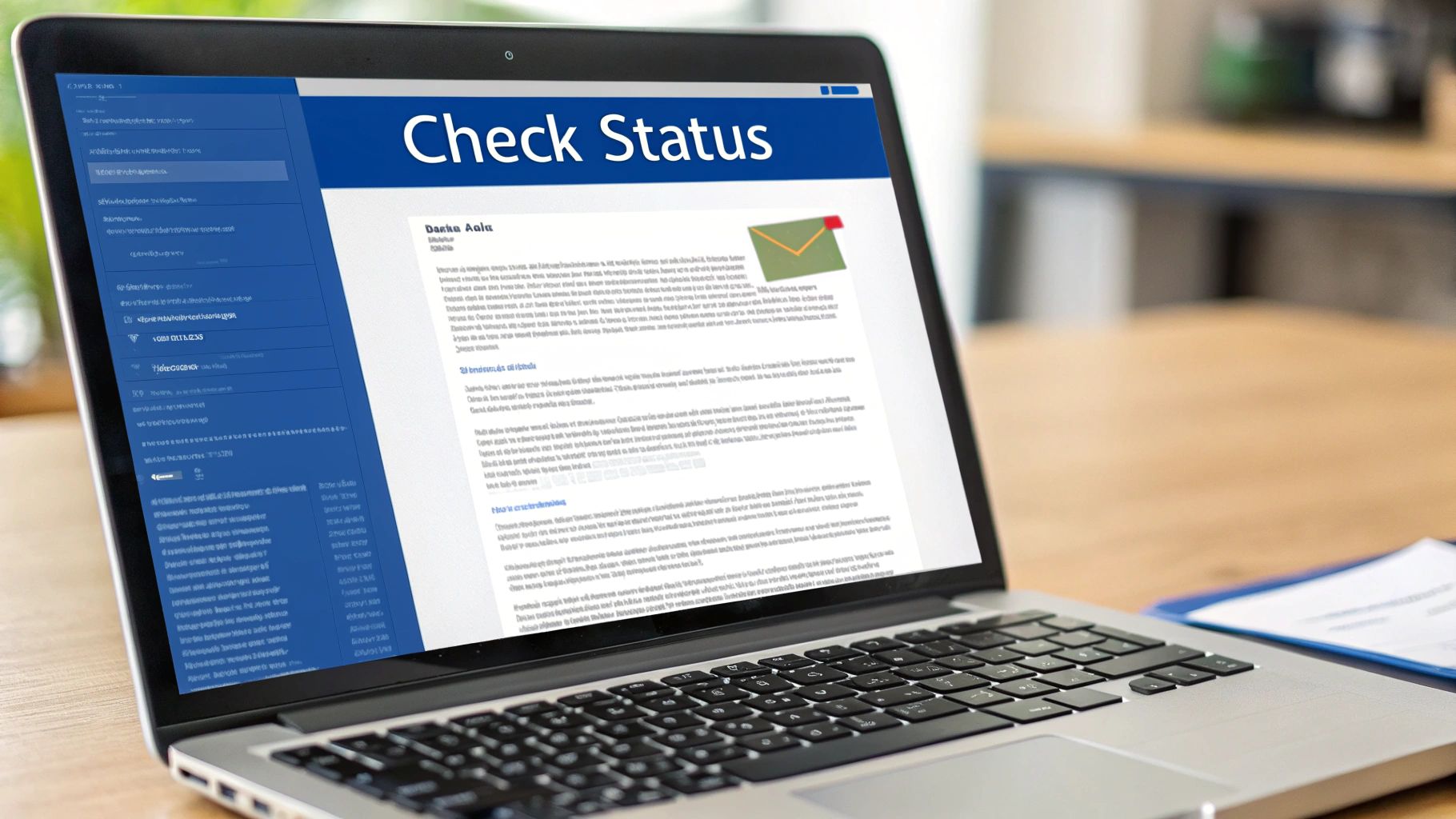Winning the Amazon Appeal Process: A Performance-First Guide to Account Reinstatement
Learn the Amazon appeal process with proven strategies to restore your seller account. Click for expert tips and prevent future issues.

Your Amazon account is suspended. That dreaded notification hits your inbox, and your revenue grinds to a halt. It's a scenario every eCommerce leader fears, and one that demands a strategic, not an emotional, response.
The Amazon appeal process isn't about begging for forgiveness. It's the official channel for presenting a data-backed, professional Plan of Action (POA). A winning POA demonstrates to Amazon that you’ve not only diagnosed the root operational failure but have implemented robust systems to prevent it from ever recurring. This is about proving you are a low-risk, high-performance partner.
Your Amazon Account Is Suspended. What To Do First

The suspension notice triggers immediate panic. Your first instinct is to fire off a rapid, emotional reply. Don't. This is the single most damaging action you can take.
The first 24 hours are critical for calculated investigation, not for writing your appeal. Rushing an appeal without a complete operational diagnosis is a guaranteed rejection. Amazon's Seller Performance teams review thousands of appeals daily; they are trained to spot and dismiss half-baked apologies. Your objective is to shift from panic to performance-driven problem-solving.
Dissect the Suspension Notice
Before touching anything, you must become an expert on that suspension email. Don't just skim it—dissect it. Print it, highlight it, and treat it like a legal document.
While Amazon's language can be frustratingly vague, it contains critical clues.
- Specific Policy Violations: Are they flagging "Inauthentic," "Intellectual Property Complaints," "Order Defect Rate," or "Used Sold as New"? Each violation points to a distinct operational breakdown.
- Mentioned ASINs: If specific ASINs are listed, they are your ground zero. These are not random examples; they are the exact products Amazon has identified as the source of the compliance failure.
- Performance Metrics: For performance-based suspensions, focus on the numbers. Did your Order Defect Rate exceed the 1% threshold? Did your Late Shipment Rate breach 4%? The data is your starting point.
A precise understanding of the accusation is the foundation of your entire strategy. Misinterpreting the violation means your POA will be irrelevant from the start.
Launch an Internal Audit Immediately
Once you know what Amazon is flagging, you must determine why it happened. This requires a brutally honest, data-driven audit of your operations. This is not a quick once-over; you are gathering the evidence that will form the core of your Plan of Action.
Your audit must be deep and specific:
- Supplier & Inventory Records: Collate all invoices, purchase orders, and letters of authorization for the ASINs in question. Do supplier details match your business information perfectly? Are invoice quantities credible against your sales velocity? Amazon investigators will cross-reference this.
- Quality Control Processes: Map your entire QC process. If the complaint is "Used Sold as New," you must trace your returns workflow. Where is the systemic gap that allowed a used item to be re-staged as sellable inventory? Pinpoint the process failure.
- Customer Communications: This is a goldmine of raw data. Analyze customer returns, A-to-z claims, chargebacks, and negative feedback. The "Voice of the Customer" dashboard in Seller Central is an invaluable diagnostic tool that too many brand leaders overlook. What are your buyers really telling you?
The Headline Takeaway: The strength of your appeal is directly proportional to the rigor of your internal audit. A suspension is a symptom of a deeper operational weakness. Treat it as such, and you will not only get reinstated but also forge a more resilient business.
Digging Deep to Find the Real Reason for Your Suspension

When the suspension notice arrives, the temptation is to offer excuses or deflect blame. Resist it. Amazon's performance investigators are not interested in excuses—they demand ownership.
The most critical factor in your reinstatement is proving you have identified the exact operational breakdown. A superficial explanation is the fastest route to a denied appeal. This is about showing them you’ve uncovered the systemic failure that led to the policy violation. Think of it this way: the violation is the symptom; you must diagnose the disease.
For instance, a suspension for "inauthentic" claims is not just about a single questionable product. That's the symptom. The root cause is the flawed process that allowed that product to enter your supply chain. You must trace it back to its origin.
Go Beyond the Obvious Explanation
To do this right, adopt an investigator's mindset. Was the root cause a new supplier who bypassed your vetting protocol? Was there a gap in your receiving team's QC checklist? Or perhaps the team creating your listings wasn't trained on trademark clearance. The answer you uncover here will define your entire Plan of Action (POA).
Consider the difference between a weak and a strong root cause analysis:
- Weak Root Cause: “We received an intellectual property complaint for using a trademarked term in our listing.”
- Strong Root Cause: “Our keyword research process, managed by a junior team member, failed to include a final cross-reference check against the USPTO trademark database. This oversight led to the unauthorized use of the term ‘[Trademarked Term]’ in the backend search terms for ASIN [B00XXXXXXX], causing the IP violation.”
The second example demonstrates rigorous analysis. It pinpoints the specific process, the personnel tier involved, and the precise point of failure. This is the level of detail Amazon requires. For a deeper dive into building your case, review our guide on handling a suspended Amazon account.
Common Scenarios and Their Actual Root Causes
Here are common suspension types and the deep-dive analysis required. Avoid generic statements; focus on the operational "why."
Inauthentic Item Complaints
- What most sellers say: "Our supplier sent us a bad batch." (This deflects blame and shows zero ownership).
- What a brand leader should say: "Our supplier verification protocol was inadequate. It did not require new suppliers to provide a letter of authorization directly from the brand owner. This gap allowed us to source from an unauthorized distributor for ASINs [List ASINs], leading to customer complaints regarding authenticity."
High Order Defect Rate (ODR)
- What most sellers say: "We got a few A-to-z claims that pushed our ODR over 1%."
- What a brand leader should say: "A software glitch in our inventory management system failed to correctly sync stock levels between our warehouse and Amazon's marketplace for a 48-hour period between [Date] and [Date]. This resulted in overselling 32 units, which we were forced to cancel, directly causing our pre-fulfillment cancellation rate to spike and our ODR to exceed the 1% threshold."
This specificity is non-negotiable. The modern amazon appeal process is a rigid, data-driven system. A compelling POA is your only tool for navigating it successfully.
The Headline Takeaway: Your root cause analysis must be a confession of a flawed business process, not an admission of a single error. Amazon must be convinced that you understand the systemic weakness before they will trust you to fix it. Presenting a specific, data-supported root cause signals to Seller Performance that you are a serious, professional seller they can reinstate with confidence.
Writing a Plan of Action That Actually Works
Let's be clear: your Plan of Action (POA) is the single most critical document in this entire process. It is not an emotional plea; it is a business plan. The investigators at Amazon's Seller Performance team are not looking for an apology. They are looking for a logical, data-backed case proving you have identified and solved a core operational flaw.
A winning POA is brutally honest, meticulously structured, and packed with specifics. It must prove you’ve not only diagnosed the root cause but have implemented measurable, lasting solutions. Think of it as a legal brief proving your operational competence.
The chart below outlines the appeal journey. Note that writing the POA is a late-stage action, performed only after a thorough investigation.

This is a crucial point many sellers miss, rushing to submit a premature appeal. That is a surefire path to rejection and prolonged downtime.
The Three Pillars of a Winning POA
Every effective POA is built on three core sections. The Amazon review team is specifically trained to look for this structure. If one pillar is weak or missing, your appeal will fail. Structure your document with these exact headings.
- The Root Cause: Explain the systemic breakdown that led to the violation. This is not about a single bad shipment; it's about the flawed process that enabled it.
- Immediate Corrective Actions: Detail what you have already done to resolve the immediate issue. This is damage control: addressing affected customers, recalling faulty inventory, and stopping the financial bleed.
- Long-Term Preventive Measures: Sell Amazon on your future reliability. Detail the new systems, software, and training you have implemented to guarantee this specific failure will never happen again. This proves you are a low-risk partner.
Expert Insight: Amazon is far more invested in your future prevention plan than your past mistakes. Acknowledging the root cause is table stakes. Proving you’ve engineered a bulletproof system for the future is what secures your reinstatement.
Weak vs Strong Plan of Action Statements
The difference between a rejected and an accepted POA lies in ownership and specifics. Vague promises signal a lack of understanding, while concrete, data-driven actions demonstrate that you have conducted a thorough audit and taken command of the situation.
For instance, if flagged for intellectual property complaints, stating "we will be more careful" is useless. Amazon needs to see a detailed, multi-step verification process that your team now follows before any new product is listed. Learn more about tackling this issue in our guide on handling an Amazon account suspension.
Let's examine real-world examples. The table below transforms weak excuses into powerful statements that resonate with Amazon investigators.
| Violation Type | Weak Statement (Rejection Risk) | Strong Statement (Performance-Focused) |
|---|---|---|
| Inauthentic Item Complaints | We will make sure our products are authentic from now on. | We have terminated our relationship with the unauthorized supplier, "Supplier X," and have recalled and destroyed all 150 units of ASIN [B00XXXXXXX] from FBA inventory (Removal Order ID: 12345). |
| High Order Defect Rate (ODR) | We will improve our customer service to lower our ODR. | Our entire customer service team (4 members) completed a mandatory refresher course on Amazon's A-to-z claim and return policies on [Date]. We also implemented a new policy requiring supervisory review for any return request unresolved after 24 hours. |
| IP Infringement | We removed the listing that had the complaint. | We have audited 100% of our catalog's backend search terms and bullet points, removing the prohibited trademarked term "[Trademark Term]" from 14 ASINs. Furthermore, we have implemented a new pre-listing SOP that requires a cross-check against the USPTO database for all primary keywords. |
The power of specifics is undeniable. Using dates, quantities, and clear action verbs transforms your POA from a weak plea into a professional business case. This is the language Seller Performance understands and respects. It signals you are a data-driven seller committed to compliance—exactly what they need to see to reinstate your account.
So You've Submitted Your Appeal. Now What?

You’ve executed your investigation, crafted a rock-solid Plan of Action, and compiled your evidence. You hit "Submit" in Seller Central, and then… silence.
Welcome to the waiting game, the most agonizing phase of the Amazon appeal process. Every day your account is down, you're hemorrhaging revenue, and the urge to do something is overwhelming. But this is where strategic, disciplined patience becomes your most valuable asset.
Submitting the appeal is just the beginning of a new phase. Firing off follow-up emails or opening new cases is one of the worst mistakes you can make. It does not expedite the review; it often resets your place in the queue.
The Art of the Strategic Wait
Once Amazon has your appeal, you are on their timeline. You are in a queue, and your primary objective is to avoid any action that sends you to the back of it.
Shortly after submission, you will almost certainly receive an automated email acknowledging receipt. This is a bot. It is not progress. A human has not reviewed your case yet. This is your first test of patience.
- Don't reply to the automated email asking for an update.
- Don't open a new case about your suspension with Seller Support.
- Don't use the "Call Me Now" button for this issue.
The Seller Performance team is an entirely separate entity from general Seller Support. Front-line support agents have zero power to influence reinstatement. These extra contacts only create case log noise and signal desperation.
What to Do When Amazon Sends a Vague Reply
If weeks pass and you finally receive a response, it is typically either reinstatement (congratulations) or a frustratingly vague request for "more information" or a more "complete" POA.
This is not a final "no." It is a test of your diligence. Amazon wants to see if you will simply resubmit the same document or if you will genuinely deepen your analysis.
Expert Insight: A vague rejection is a prompt for a more rigorous audit, not a dead end. Re-examine your root cause analysis. Were your solutions superficial fixes or fundamental system changes? Did you provide sufficient hard evidence? Bolster your POA with more data and more specific preventative actions before resubmitting.
When—and How—to Escalate
What if you face absolute radio silence for weeks? Amazon's internal review process can be opaque and inefficient. It's not uncommon for cases to get stuck. While the official guidance is a review time of a few days, some sellers wait much longer. Out of frustration, some sellers have submitted over 15 appeals for a single suspension.
Only after a significant period of silence—at least two to three weeks with no response—should you consider a follow-up. When you do, it must be a polite, professional nudge on your original case log. Do not create a new appeal.
Use a simple, professional template:
"To the Seller Performance Team,
We are writing to follow up on the Plan of Action we submitted on [Date] for Case ID [Your Case ID]. We have fully implemented the corrective and preventive measures outlined in our plan and are awaiting your review.
For your convenience, we have attached our original POA and supporting documents again. Thank you for your time and consideration."
This approach is respectful and organized. It keeps all information consolidated and avoids disrupting your place in the queue. Navigating this phase requires a steady hand and the understanding that a superior POA, backed by immense patience, is your clearest path back to selling.
Building a Resilient Business to Prevent Future Suspensions
Reinstatement is a relief, but it's not the end of the work. For serious brands on Amazon, the real goal is to pivot from crisis management to building an operation so robust that compliance issues become a relic of the past. The lessons learned during the appeal process must be embedded into your daily operational DNA.
This isn't about penalty avoidance; it's about building an operational machine that becomes a competitive moat. When your systems are airtight, you can stop managing risk and start driving what truly matters: profitable growth.
Fortify Your Supply Chain
A weak supply chain is the single greatest vulnerability for Amazon sellers, particularly for inauthentic or IP-related complaints. Supplier vetting cannot be a one-time task; it must be a continuous, data-driven process.
- Invoices Are Not Enough: An invoice is the bare minimum. The gold standard is a Letter of Authorization (LOA) directly from the brand owner, especially when sourcing from distributors. This is your non-negotiable proof.
- Quarantine New Inventory: Never send a large shipment from a new supplier directly to FBA. Implement a "quarantine" protocol: send a small test batch, monitor sales and customer feedback for at least 30 days, and only then consider a larger purchase order.
- Audit Annually: Do not become complacent with long-term suppliers. Re-vet them annually. Distribution rights change, businesses are sold, and you must verify your source remains legitimate.
Run Your Own Internal Audits
A suspension is a lagging indicator; it signals that a part of your business has been broken for some time. The only way to find these vulnerabilities before Amazon does is to conduct your own rigorous, proactive audits. The warning signs were almost certainly present in your account data for weeks.
The Headline Takeaway: Do not wait for Amazon's bots to police your business. By the time your Account Health dashboard turns yellow, you are already behind. Building a proactive, data-driven internal audit culture is the only sustainable way to protect your revenue and scale on the marketplace.
Your leadership team should run a dedicated "Account Health Check" weekly. This is not a quick glance at a dashboard. It's a deep dive into the metrics that signal future trouble.
Your Proactive Health Checklist:
- Voice of the Customer (VOC): Analyze the VOC dashboard for negative trends. Is one ASIN repeatedly flagged for "quality" or "wrong item"? This is your earliest warning.
- Return Reasons: Scrutinize your FBA return reports. A sudden spike in returns for "defective" or "not as described" on a specific product is a massive red flag demanding an immediate check of your physical inventory and listing accuracy.
- Performance Notifications: Read and action every single one. A minor policy warning today can escalate into a full suspension tomorrow if the root cause is not addressed across your entire catalog.
- Ad Performance Dips: Often, the first sign of an account health issue appears in your advertising data. A sudden drop in conversion rate for a key product could signal a lost Buy Box, new negative reviews, or a suppressed listing. If you see that your Amazon advertising not working as expected, it may be a symptom of a deeper operational problem.
By transforming the painful lessons of a suspension into a proactive operational rhythm, you shift your business from reactive to resilient, creating a powerful competitive advantage.
Common Questions About the Amazon Appeal Process
Even with a perfect Plan of Action, the Amazon appeal process is an opaque and frustrating ordeal. Here are no-nonsense answers to the questions we hear most frequently from brand leaders navigating a crisis.
How Long Does an Amazon Appeal Usually Take?
Amazon's stated goal is to review appeals in 3 to 5 business days. In practice, this is highly variable. I’ve seen simple cases resolved in hours and complex IP issues drag on for weeks.
Key variables include:
- Suspension Type: A straightforward Order Defect Rate issue is typically faster to resolve than a complex intellectual property complaint involving multiple rights owners.
- Plan of Action Quality: A clear, data-backed, and well-structured POA moves significantly faster. Vague or incomplete appeals are deprioritized or rejected.
- Timing: Submitting an appeal during Q4 or another peak sales period will almost certainly result in a longer review time due to increased volume.
The fastest way to reinstatement is to get it right the first time. Rushing your appeal guarantees a longer period of lost sales.
Should I Contact Seller Support or Use the Call Me Now Button?
No. To be unequivocal: standard Seller Support representatives have zero authority or influence over account suspensions. They are not part of the Seller Performance or Product Quality teams.
Contacting Seller Support about a suspension is a common and critical error. It wastes time, generates bad advice, and can clutter your case log, potentially disrupting your place in the review queue. All communication must be funneled through the official appeal button in Seller Central associated with your suspension notice.
Expert Insight: Adhere strictly to the official process. The "Call Me Now" button is for tactical, day-to-day operational issues, not for appealing a strategic decision made by the teams that hold the power of reinstatement.
What if My First Appeal Is Rejected?
A rejection is not the end, but it is a clear signal that your analysis was insufficient. Do not resubmit the same document. A rejection means the investigator who reviewed your case was unconvinced by your diagnosis or your solution.
Rejections typically stem from two primary weaknesses:
- Weak Root Cause: You failed to identify the core systemic breakdown.
- Insufficient Preventive Measures: Your proposed solutions were generic, temporary, or unconvincing.
Analyze Amazon's rejection email carefully. Even template responses often contain keywords that hint at the deficiency. Go back to your POA, dig deeper into the data, add more specific evidence, and engineer stronger, more permanent fixes before you resubmit. Each submission is an opportunity to prove you are a professional, data-driven leader who takes compliance seriously.
A suspension often illuminates the critical link between operational health, brand reputation, and advertising performance. At Headline, we go beyond simple campaign management. We leverage performance data to build resilient brands that can withstand marketplace volatility and drive sustainable growth. Schedule a call with a Headline expert and let's discuss how to transform your Amazon presence into a more powerful, profitable, and defensible business.
Ready to Transform Your Amazon PPC Performance?
Get a comprehensive audit of your Amazon PPC campaigns and discover untapped growth opportunities.